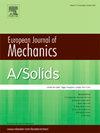Electro-mechanically coupled pure-shear cyclic deformation of dielectric elastomers at different temperatures: Experiments and constitutive model
IF 4.4
2区 工程技术
Q1 MECHANICS
引用次数: 0
Abstract
This study initially conducts experimental observations on the electro-mechanically coupled pure-shear cyclic deformation of VHB™4910 dielectric elastomer at varying temperatures. The experimental results indicate that the temperature alteration has a considerable impact on the electro-mechanically coupled deformation of this elastomer. Under the strain-controlled cyclic deformation, the voltage application causes a decrease of stress response; but its decreased amount at different temperatures is almost the same. Under the stress-controlled cyclic deformation, the voltage application increases the ratchetting strain of the elastomer, leading to a reduction of sample thickness, which further amplifies the effect of voltage; meanwhile, the impact of voltage on the ratchetting amplifies as the temperature increases. Moreover, the electro-mechanically coupled cyclic deformation of VHB™4910 dielectric elastomer also shows significant loading level/loading rate dependence. Based on the experimental results, a temperature-dependent electro-mechanically coupled visco-hyperelastic constitutive model is presented. In the developed model, the strongly temperature-dependence of viscoelastic behavior and the role of voltage application of the elastomer are considered by incorporating the temperature-dependent shear modulus and dielectric constant. Finally, comparing the experimental results and simulated ones demonstrates that the developed model has a good capability for capturing the temperature-dependent electro-mechanically coupled cyclic deformation of dielectric elastomers.
介电弹性体在不同温度下的电-机械耦合纯剪切循环变形:实验和构成模型
本研究首先对VHB™4910介电弹性体在不同温度下的机电耦合纯剪切循环变形进行了实验观察。实验结果表明,温度变化对弹性体的机电耦合变形有较大的影响。在应变控制的循环变形下,施加电压使应力响应减小;但其在不同温度下的减少量几乎相同。在应力控制的循环变形下,施加电压使弹性体的棘轮应变增大,导致试样厚度减小,进一步放大了电压效应;同时,电压对棘轮的影响随着温度的升高而增大。此外,VHB™4910介电弹性体的机电耦合循环变形也表现出显著的加载水平/加载速率依赖性。在实验结果的基础上,建立了温度相关的机电耦合粘-超弹性本构模型。在建立的模型中,考虑了弹性体粘弹性行为的强烈温度依赖性和电压施加的作用,纳入了与温度相关的剪切模量和介电常数。最后,将实验结果与仿真结果进行了比较,结果表明所建立的模型能够很好地捕捉介电弹性体随温度变化的机电耦合循环变形。
本文章由计算机程序翻译,如有差异,请以英文原文为准。
求助全文
约1分钟内获得全文
求助全文
来源期刊
CiteScore
7.00
自引率
7.30%
发文量
275
审稿时长
48 days
期刊介绍:
The European Journal of Mechanics endash; A/Solids continues to publish articles in English in all areas of Solid Mechanics from the physical and mathematical basis to materials engineering, technological applications and methods of modern computational mechanics, both pure and applied research.

 求助内容:
求助内容: 应助结果提醒方式:
应助结果提醒方式:


